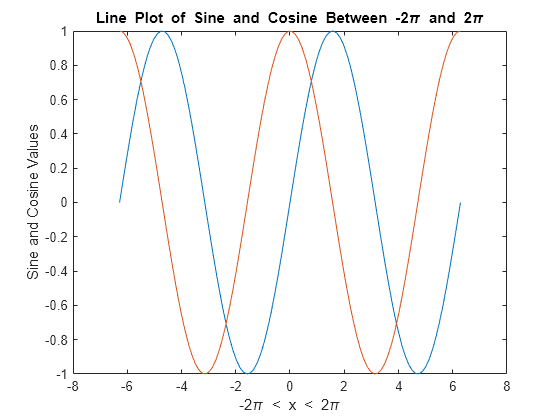Ajouter un titre et des étiquettes aux axes d'un graphique
Cet exemple montre comment ajouter un titre et des étiquettes aux axes d'un graphique avec les fonctions title, xlabel et ylabel. Il montre également comment personnaliser l’apparence du texte des axes en modifiant la taille de la police.
Créer un tracé linéaire simple
Créez x comme une variable représentant 100 valeurs espacées linéairement entre et . Créez y1 et y2 comme variables représentants les valeurs de sinus et de cosinus de x. Tracez les deux jeux de données.
x = linspace(-2*pi,2*pi,100); y1 = sin(x); y2 = cos(x); figure plot(x,y1,x,y2)

Ajouter un titre
Ajoutez un titre au graphique avec la fonction title. Pour afficher le symbole grec , utilisez la commande TeX \pi.
title('Line Plot of Sine and Cosine Between -2\pi and 2\pi')
Ajouter des étiquettes aux axes
Ajoutez des étiquettes aux axes d'un graphique avec les fonctions xlabel et ylabel.
xlabel('-2\pi < x < 2\pi') ylabel('Sine and Cosine Values')

Ajouter une légende
Ajoutez une légende au graphique pour identifier chaque jeu de données avec la fonction legend. Spécifiez les descriptions de la légende en suivant l’ordre dans lequel vous avez tracé les lignes. Si vous le souhaitez, spécifiez l’emplacement de la légende en utilisant l’une des huit directions cardinales ou intercardinales, soit 'southwest' dans cet exemple.
legend({'y = sin(x)','y = cos(x)'},'Location','southwest')
Modifier la taille de la police
Les objets Axes ont des propriétés qui permettent de personnaliser l’apparence des axes. Par exemple, la propriété FontSize contrôle la taille de police du titre, des étiquettes et de la légende.
Accédez à l’objet courant Axes avec la fonction gca. Utilisez ensuite la notation à point (.) pour définir la propriété FontSize.
ax = gca; ax.FontSize = 13;

À partir de la version R2022a, il est également possible de modifier la taille de police du texte des axes avec la fonction fontsize.
Titre contenant une valeur de variable
Insérez une valeur de variable dans le texte du titre en utilisant la fonction num2str pour convertir cette valeur en texte. Vous pouvez procéder de la même manière pour ajouter des valeurs de variables dans les étiquettes des axes ou les descriptions de la légende.
Ajoutez un titre contenant la valeur de .
k = sin(pi/2);
title(['sin(\pi/2) = ' num2str(k)])
Voir aussi
title | xlabel | ylabel | legend | linspace | fontsize